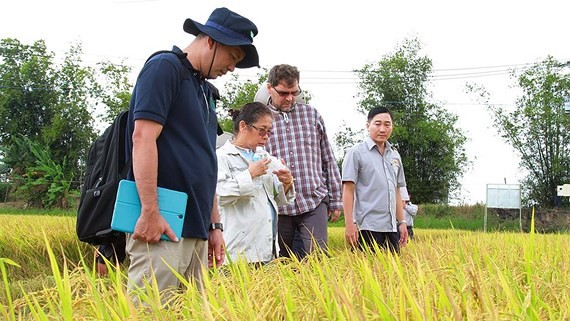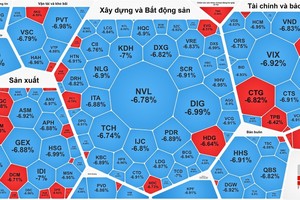
However, thanks to the activeness of enterprises, Vietnam’s rice export has had positive changes.
Figures by the General Department of Vietnam Customs showed that in the first five months of this year, firms exported 2.76 million tons of rice, worth US$1.18 billion, a drop of 6.3 percent in volume and 20.4 percent in value compared to the same period last year. Mr. Phan Van Chinh, head of the Agency of Foreign Trade under the Ministry of Industry and Trade, said that the country’s rice export faced several disadvantages as there was no large enough contract to lead the market.
Medium to large traditional markets of Vietnamese rice all cut rice exports due to various reasons. China had a large amount of rice inventory and even competed with other rice exporters, including Vietnam, by exporting old rice to African countries. Indonesia became subdued during the year of election while Bangladesh recovered rice production after suffering flooding. As a result, it is forecasted that rice market would remain gloomy for the rest of this year. This continues to put pressure on consumption of the summer-autumn rice crop this year.
Nevertheless, the ministry has also recorded that many enterprises have quickly adapted to changes in rice import policies of the Philippines. As Vietnamese firms were able to expand export of rice to this market, the country did not see a slump as sharply as some other countries. There were also changes in market structure and rice variety structure as well as efforts to seek for new markets of Vietnamese rice exporters in the first months of this year.
Vietnamese rice has been strongly exported to Africa, Europe, America and the Middle East region. This year, Iraq is expected to import a steady amount of around 300,000 tons of rice from Vietnam. Several African countries, including Ivory Coast, Ghana, South Africa, Mozambique and Angola, had increased import of Vietnamese fragrant rice at the beginning of this year.
In addition, firms can take advantage of preferential treatments for rice at countries which have already signed free trade agreements with Vietnam, and bilateral agreements, such as a quota of 10,000 tons per year with import tariff of zero percent to the market of the Eurasian Economic Union. Vietnam also has just finished negotiations with South Korea on rice export quota to this country at a fairly good price. The signing of the free trade agreement between Vietnam and the European Union creates more opportunities for Vietnamese rice to enter this market in the near future.
According to Mr. Le Minh Duc, director of the Department of Industry and Trade of Long An Province, the current difficult of domestic rice exporting and consuming is excessive rice supply. It is forecasted that demand for Vietnamese rice import is around 5 million tons whereas the country’s rice production capacity is up to 7 million tons.
Therefore, the Ministry of Agriculture and Rural Development and provinces should consider the appropriate rice production and area of land for rice cultivation. At the same time, they should also review cultivation schedule and make cultivation schedule reasonable and suitable with the market so as to lessen pressure on warehouses and rice dyers.
Mr. Pham Thien Nghia, vice chairman of the People’s Committee of Dong Thap Province, said that it is time to check whether rice is the key export product of Vietnam when rice export turnover is lower than that of aquatic products and vegetables and fruits. Several provinces have shifted from rice cultivation to aquaculture and fruit tree cultivation.
According to Mr. Tran Quoc Khanh, deputy minister of the Ministry of Industry and Trade, amid unfavorable market, firms should join hands with the Government to resolve difficulties. In short term, the ministry will build a stable mechanism, creating conditions for firms to buy rice for farmers.
At the same time, ministries should collaborate to update market information to help firms to have an overview and understand the market. The Ministry of Industry and Trade and the Ministry of Agriculture and Rural Development will cooperate to put forth detail mechanism for the development of rice industry and report to the Government for reasonable development policy. Firms should co-ordinate with the Vietnam Food Association to build brands, packing and labels. Of which, each firm must ensure quality, keep its prestige and avoid breaking contract so as not to cause negative impacts on the brand name of Vietnamese rice. At the same time, firms should improve administrative ability to search for new markets.
Medium to large traditional markets of Vietnamese rice all cut rice exports due to various reasons. China had a large amount of rice inventory and even competed with other rice exporters, including Vietnam, by exporting old rice to African countries. Indonesia became subdued during the year of election while Bangladesh recovered rice production after suffering flooding. As a result, it is forecasted that rice market would remain gloomy for the rest of this year. This continues to put pressure on consumption of the summer-autumn rice crop this year.
Nevertheless, the ministry has also recorded that many enterprises have quickly adapted to changes in rice import policies of the Philippines. As Vietnamese firms were able to expand export of rice to this market, the country did not see a slump as sharply as some other countries. There were also changes in market structure and rice variety structure as well as efforts to seek for new markets of Vietnamese rice exporters in the first months of this year.
Vietnamese rice has been strongly exported to Africa, Europe, America and the Middle East region. This year, Iraq is expected to import a steady amount of around 300,000 tons of rice from Vietnam. Several African countries, including Ivory Coast, Ghana, South Africa, Mozambique and Angola, had increased import of Vietnamese fragrant rice at the beginning of this year.
In addition, firms can take advantage of preferential treatments for rice at countries which have already signed free trade agreements with Vietnam, and bilateral agreements, such as a quota of 10,000 tons per year with import tariff of zero percent to the market of the Eurasian Economic Union. Vietnam also has just finished negotiations with South Korea on rice export quota to this country at a fairly good price. The signing of the free trade agreement between Vietnam and the European Union creates more opportunities for Vietnamese rice to enter this market in the near future.
According to Mr. Le Minh Duc, director of the Department of Industry and Trade of Long An Province, the current difficult of domestic rice exporting and consuming is excessive rice supply. It is forecasted that demand for Vietnamese rice import is around 5 million tons whereas the country’s rice production capacity is up to 7 million tons.
Therefore, the Ministry of Agriculture and Rural Development and provinces should consider the appropriate rice production and area of land for rice cultivation. At the same time, they should also review cultivation schedule and make cultivation schedule reasonable and suitable with the market so as to lessen pressure on warehouses and rice dyers.
Mr. Pham Thien Nghia, vice chairman of the People’s Committee of Dong Thap Province, said that it is time to check whether rice is the key export product of Vietnam when rice export turnover is lower than that of aquatic products and vegetables and fruits. Several provinces have shifted from rice cultivation to aquaculture and fruit tree cultivation.
According to Mr. Tran Quoc Khanh, deputy minister of the Ministry of Industry and Trade, amid unfavorable market, firms should join hands with the Government to resolve difficulties. In short term, the ministry will build a stable mechanism, creating conditions for firms to buy rice for farmers.
At the same time, ministries should collaborate to update market information to help firms to have an overview and understand the market. The Ministry of Industry and Trade and the Ministry of Agriculture and Rural Development will cooperate to put forth detail mechanism for the development of rice industry and report to the Government for reasonable development policy. Firms should co-ordinate with the Vietnam Food Association to build brands, packing and labels. Of which, each firm must ensure quality, keep its prestige and avoid breaking contract so as not to cause negative impacts on the brand name of Vietnamese rice. At the same time, firms should improve administrative ability to search for new markets.
























